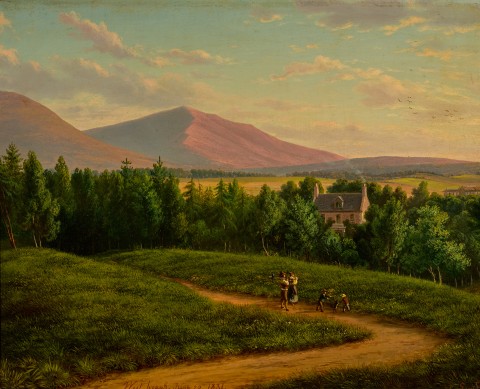WEST BROOK, JUNE 29, 1831, c.1860
EUGENE VON GUÉRARD
oil on academy board
28.0 x 35.0 cm
signed with initials lower right: E. v. G.
inscribed with title lower centre: West brook. June 29. 1831.
Private collection
Mr and Mrs Frank Lewis, Melbourne, acquired c.1965
Clune Galleries, Sydney
Private collection, Sydney, acquired from the above in October 1972
Leonard Joel, Melbourne, 23 May 1975, lot 859
Private collection, Sydney
Sotheby’s, Melbourne, 30 April 2002, lot 50 (dated c.1870)
The Cbus Collection of Australian Art, Melbourne, acquired from the above
Eugen Von Guerard. An Exhibition of Paintings and Prints, Clune Galleries, Sydney, October 1972, cat. 1 (as ‘Westbrook’)
Overland, Latrobe Regional Gallery, Victoria, 10 March – 15 July 2012
on long term loan to Queen Victoria Museum and Art Gallery, Tasmania (label attached verso)
Bruce, C., Comstock, E., and McDonald, F., Eugene von Guérard: A German Romantic in the Antipodes, Alister Taylor, Sydney, 1982, cat. 59, p. 213 (as ‘Westbrook’)
Nainby, B., Stanhope, Z., and Furlonger, K., The Cbus Collection of Australian Art, in association with Latrobe Regional Gallery, Melbourne, 2009, p. 236
This beautifully realised work is one of the most intriguing and enigmatic of Eugene von Guérard’s entire career. Both the inscription, ‘West brook. June 29. 1831,’ and the architectural style of the house suggest an English subject. However, in 1831 von Guerard was far from England: the nineteen-year-old had just embarked on his artistic training in Rome under the Italian landscape painter, Giambattista Bassi. Although he passed through London en route to Australia in August 1852 and spent the last decade of his life there, this work cannot be linked with either period.
Von Guérard’s use of the English form of ‘June’ indicates that West Brook was painted after he arrived in the English-speaking colony of Victoria, probably to fulfil a patron’s desire for an image of ‘home.’ Many in the colony would have shared the feelings of von Guérard’s close friend, the art critic James Smith, who wrote movingly and in explicit detail of his memories of his childhood home in the village of Loose in Kent.1 Von Guérard and Smith certainly shared their memories of Europe – the artist painted an Italian subject for Smith in 1859 – and while it is tempting to imagine that this work depicts Smith’s childhood home, and ‘Westbrook,’ a house that still stands in Loose, this is not supported by the visual evidence.2
West Brook, June, 29, 1831, c.1860 with its reference to a specific date, seemingly alludes to a time and place of deep personal significance for its unknown patron, and to a particular memory encapsulated in the cameo of the children playing with their dog, watched over by a couple returning from their toil in the fields visible beyond the house. Perhaps working from a verbal description or sketches provided to him, von Guérard depicted the portico, paned windows, attic and chimney pots of the stone house in meticulous detail; the firs and larches that surround the house were informed by studies in his German sketchbooks. Less typical of England are the barren peaks that rise in the distance: modelled in a palette of dusty pinks with violet shadows they are more akin to the mountains found in the artist’s Australian works, for example, A View from Mt Franklin towards Mount Kooroocheang and the Pyrenees, c. 1864.
Von Guérard conveyed a sense of the evidently happy memories that were the genesis of this painting in the warmth of his palette and the similarly warm late afternoon light that washes over this bucolic scene. Every blade of grass, every wildflower and every leaf on every tree is individuated in rich strokes of pigment and, as is typical of his best works, becomes part of a unified and harmonious composition.
1. James Smith, Private Diary, 10 March 1863. Smith Papers, Mitchell Library, State Library of New South Wales, MS 212; James Smith , ‘An English Village Fifty Years Ago’, Argus, 19 April 1879
2. Eugene von Guérard Temple of Apollo and Lake Avernus, 1859, oil on millboard, 27.8 x 35.6 cm, collection of the Art Gallery of Ballarat
DR RUTH PULLIN
